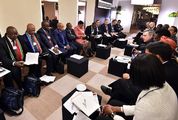Source:

BUSINESS DAY TV: Feasibility study under way on extending Gautrain network
by Transcript Services, January 26 2016,
2016-01-27 19:53:16.0
Transcript Services, January 26 2016
BUSINESS DAY TV: Feasibility study under way on extending Gautrain network
JACK van der Merwe is Gautrain CEO.
BUSINESS DAY TV: It’s all aboard for bidders for a lucrative R3.5bn tender to supply Gautrain with 48 new coaches, which will help to accommodate the increasing number of passengers using the train service. The bidding process is for the appointment of their company, which will design, manufacture, supply and maintain the 12 new trains.
Joining us on News Leader for more detail is Jack van der Merwe, CEO of Gautrain Management Agency. Jack...let’s take a step back. Of course the expansion that you’re catering to, is speaking to just how successful the Gautrain has been over the period so far, and the demand you’re actually catering to right now.
JACK VAN DER MERWE: Yes. Remember we started off on a totally Greenfields project. Everybody told us that if you want to move people from their cars to the train is going to be very difficult. Seventy-seven per cent of our ridership are actually people who have left their cars at home, who used to go by car and are now using the train. So we are actually victims of our own success.
BDTV: And you have been given a helping hand by things like the e-tolls here in Gauteng because that did see passenger numbers increase. What else do you attribute the success of the Gautrain to and the growing number of passengers?
JVDM: Firstly, it’s government policy to move towards public transport and what Gautrain has done is that it’s created a viable alternative. It’s created something where you’re willing to leave your car at home and come to the train. So that’s the first part. The second thing is that Gauteng as a province is very small and congested...as the economy grows congestion gets worse. So it’s actually the carrot and stick. The carrot side is the good system, but the stick is actually congestion and we’re finding that the petrol price increase has had a much bigger effect on the ridership than the e-tolls. The e-tolls were phased in over such a long period that it was actually watered down.
BDTV: And very few people pay them anyway...
JVDM: Yes, but I believe in our case it’s a question of predictability of your trip. On the train you know that it takes 42 minutes from Park Station to Hatfield. In your car it could be anything.
BDTV: Yes. So how much new route does this new plan bring to the fore and where does the expansion plan actually take the Gautrain?
JVDM: Remember, we’re busy with two processes. The one is the existing 80km system and on that we’re going to deploy the 48 coaches. Apart from that we are busy with a feasibility study on extending the network. But that’s something that we’ll announce...the results of the feasibility around March-April...the Premier will announce it.
So we’re going to park that at the moment but in terms of the 25-year plan, we’re looking at running from Mamelodi to the east of Pretoria, 45 degrees down to Soweto in the west of Johannesburg, and then linking Lanseria into Cosmos, into Randburg, into Sandton and then extending down from the airport into Boksburg.
BDTV: If you look at the existing routes there are approximately 1.4-million commuters a month using the Gautrain. With the 48 new coaches on the 12 trains...four coaches per train, how many new passengers can you accommodate?
JVDM: In public transport you have supply and demand and in peak the demand is more than the supply. In the off-peak we have much spare capacity. So what this will do is create more capacity in the peak periods. So we are planning to run shorter shuttles, we’re going to run a service in between from Centurion Station to Marlboro or Sandton so that we run a shorter link. So it just makes it more flexible and you can actually address this peak crisis that we have.
BDTV: Within what kind of timeline?
JVDM: Again we’re actually in the hands of the bidders because they have to manufacture. We have to have 65% local content and it depends on how they structure them in SA. We’ve had documents being drawn by Alstom, the Gibela Group and as you know they’re going to prepare the Prasa trains, so if they have a side-line on their production line we could see the roll-out of the trains a lot faster. So it will be 18–24 months from now.
BDTV: So seven companies have been shortlisted, including two local companies. What will you be looking for in a successful bidder?
JVDM: We are looking for a consortium and in the PPP process you look at technical competency, at the financial model and then at the legal competency. But in SA we’ve added a fourth leg which we call socioeconomic development. So we’re looking at a company that will create jobs, create skills...all the targets that we are aiming at in the current South African situation. So it’s a consortium that we’re looking for.
BDTV: And talk us through the funding. How is this going to be funded?
JVDM: This morning MEC Barbara Creecy said that the ground rule was that we couldn’t ask any more money from the fiscus, so the proposal had to be fiscus neutral which is quite a challenge. But what we’ve done is that by having more rolling stock we would create more money and we will be allowed to keep that extra money so we will actually repay the loan through the extra income in the system, and we have the DBSA that is underwriting this loan and they’ve allowed us to pay it off over a longer period.
BDTV: There have been suggestions that the Gautrain is doing so much better than initially expected perhaps that the subsidy that you get from the Gauteng government will eventually be reduced. Where does that stand at the moment because last year I believe it was just over R1bn that the Gauteng government subsidised Gautrain for?
JVDM: We pay a monthly amount and it hovers around R1bn.
BDTV: Is that built on passenger numbers?
JVDM: It’s built on a patronage guarantee so it’s actually offsetting. We have in the contract document, the minimum required total revenue and that minimum required total revenue will then cover operating costs, maintenance costs, servicing of the loan of the concessionaire and profit and that is made good by the sales of the tickets plus value-add like advertisements and then we top it up with a patronage guarantee, so that’s the amount that we pay...and that will reduce as the numbers increase.
BDTV: What do you foresee as your biggest challenge going down this road?
JVDM: The challenge on the different companies will be to slot into the existing system because remember they are going to operate trains which run (in terms of) the regime which we have structured for the Gautrain. So they have to fit into it, they have to be able to run from Park to Hatfield in 42 minutes so the whole signalling and the whole interoperability is the one challenge.
The other challenge is around socioeconomic development, is to get the right partners to reach the 65% local content which is now a Treasury regulation for production of trains in SA.
2016-01-27 19:51:11.0
JACK van der Merwe is Gautrain CEO.
BUSINESS DAY TV: It’s all aboard for bidders for a lucrative R3.5bn tender to supply Gautrain with 48 new coaches, which will help to accommodate the increasing number of passengers using the train service. The bidding process is for the appointment of their company, which will design, manufacture, supply and maintain the 12 new trains.
Joining us on News Leader for more detail is Jack van der Merwe, CEO of Gautrain Management Agency. Jack...let’s take a step back. Of course the expansion that you’re catering to, is speaking to just how successful the Gautrain has been over the period so far, and the demand you’re actually catering to right now.
JACK VAN DER MERWE: Yes. Remember we started off on a totally Greenfields project. Everybody told us that if you want to move people from their cars to the train is going to be very difficult. Seventy-seven per cent of our ridership are actually people who have left their cars at home, who used to go by car and are now using the train. So we are actually victims of our own success.
BDTV: And you have been given a helping hand by things like the e-tolls here in Gauteng because that did see passenger numbers increase. What else do you attribute the success of the Gautrain to and the growing number of passengers?
JVDM: Firstly, it’s government policy to move towards public transport and what Gautrain has done is that it’s created a viable alternative. It’s created something where you’re willing to leave your car at home and come to the train. So that’s the first part. The second thing is that Gauteng as a province is very small and congested...as the economy grows congestion gets worse. So it’s actually the carrot and stick. The carrot side is the good system, but the stick is actually congestion and we’re finding that the petrol price increase has had a much bigger effect on the ridership than the e-tolls. The e-tolls were phased in over such a long period that it was actually watered down.
BDTV: And very few people pay them anyway...
JVDM: Yes, but I believe in our case it’s a question of predictability of your trip. On the train you know that it takes 42 minutes from Park Station to Hatfield. In your car it could be anything.
BDTV: Yes. So how much new route does this new plan bring to the fore and where does the expansion plan actually take the Gautrain?
JVDM: Remember, we’re busy with two processes. The one is the existing 80km system and on that we’re going to deploy the 48 coaches. Apart from that we are busy with a feasibility study on extending the network. But that’s something that we’ll announce...the results of the feasibility around March-April...the Premier will announce it.
So we’re going to park that at the moment but in terms of the 25-year plan, we’re looking at running from Mamelodi to the east of Pretoria, 45 degrees down to Soweto in the west of Johannesburg, and then linking Lanseria into Cosmos, into Randburg, into Sandton and then extending down from the airport into Boksburg.
BDTV: If you look at the existing routes there are approximately 1.4-million commuters a month using the Gautrain. With the 48 new coaches on the 12 trains...four coaches per train, how many new passengers can you accommodate?
JVDM: In public transport you have supply and demand and in peak the demand is more than the supply. In the off-peak we have much spare capacity. So what this will do is create more capacity in the peak periods. So we are planning to run shorter shuttles, we’re going to run a service in between from Centurion Station to Marlboro or Sandton so that we run a shorter link. So it just makes it more flexible and you can actually address this peak crisis that we have.
BDTV: Within what kind of timeline?
JVDM: Again we’re actually in the hands of the bidders because they have to manufacture. We have to have 65% local content and it depends on how they structure them in SA. We’ve had documents being drawn by Alstom, the Gibela Group and as you know they’re going to prepare the Prasa trains, so if they have a side-line on their production line we could see the roll-out of the trains a lot faster. So it will be 18–24 months from now.
BDTV: So seven companies have been shortlisted, including two local companies. What will you be looking for in a successful bidder?
JVDM: We are looking for a consortium and in the PPP process you look at technical competency, at the financial model and then at the legal competency. But in SA we’ve added a fourth leg which we call socioeconomic development. So we’re looking at a company that will create jobs, create skills...all the targets that we are aiming at in the current South African situation. So it’s a consortium that we’re looking for.
BDTV: And talk us through the funding. How is this going to be funded?
JVDM: This morning MEC Barbara Creecy said that the ground rule was that we couldn’t ask any more money from the fiscus, so the proposal had to be fiscus neutral which is quite a challenge. But what we’ve done is that by having more rolling stock we would create more money and we will be allowed to keep that extra money so we will actually repay the loan through the extra income in the system, and we have the DBSA that is underwriting this loan and they’ve allowed us to pay it off over a longer period.
BDTV: There have been suggestions that the Gautrain is doing so much better than initially expected perhaps that the subsidy that you get from the Gauteng government will eventually be reduced. Where does that stand at the moment because last year I believe it was just over R1bn that the Gauteng government subsidised Gautrain for?
JVDM: We pay a monthly amount and it hovers around R1bn.
BDTV: Is that built on passenger numbers?
JVDM: It’s built on a patronage guarantee so it’s actually offsetting. We have in the contract document, the minimum required total revenue and that minimum required total revenue will then cover operating costs, maintenance costs, servicing of the loan of the concessionaire and profit and that is made good by the sales of the tickets plus value-add like advertisements and then we top it up with a patronage guarantee, so that’s the amount that we pay...and that will reduce as the numbers increase.
BDTV: What do you foresee as your biggest challenge going down this road?
JVDM: The challenge on the different companies will be to slot into the existing system because remember they are going to operate trains which run (in terms of) the regime which we have structured for the Gautrain. So they have to fit into it, they have to be able to run from Park to Hatfield in 42 minutes so the whole signalling and the whole interoperability is the one challenge.
The other challenge is around socioeconomic development, is to get the right partners to reach the 65% local content which is now a Treasury regulation for production of trains in SA.





















Login OR Join up TO COMMENT